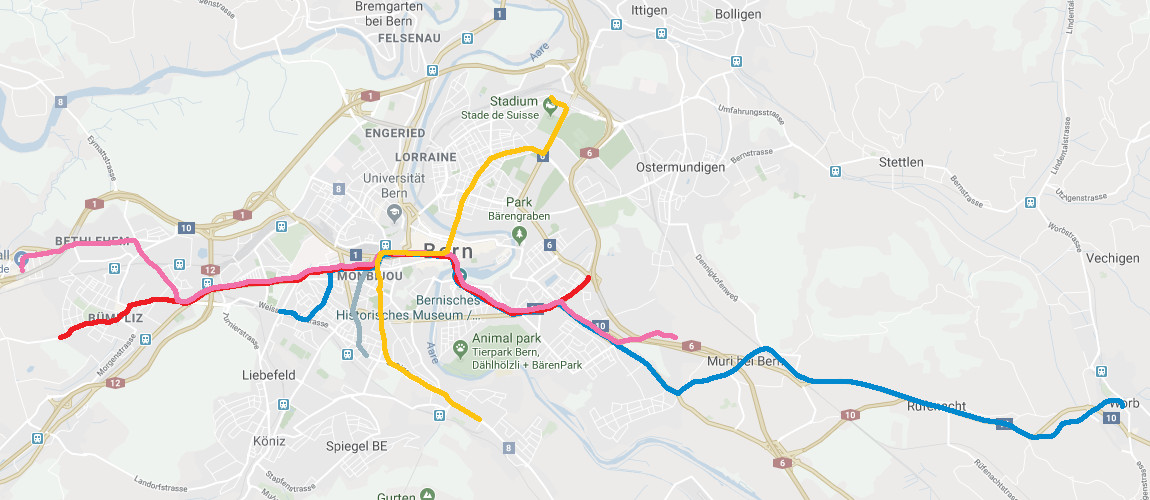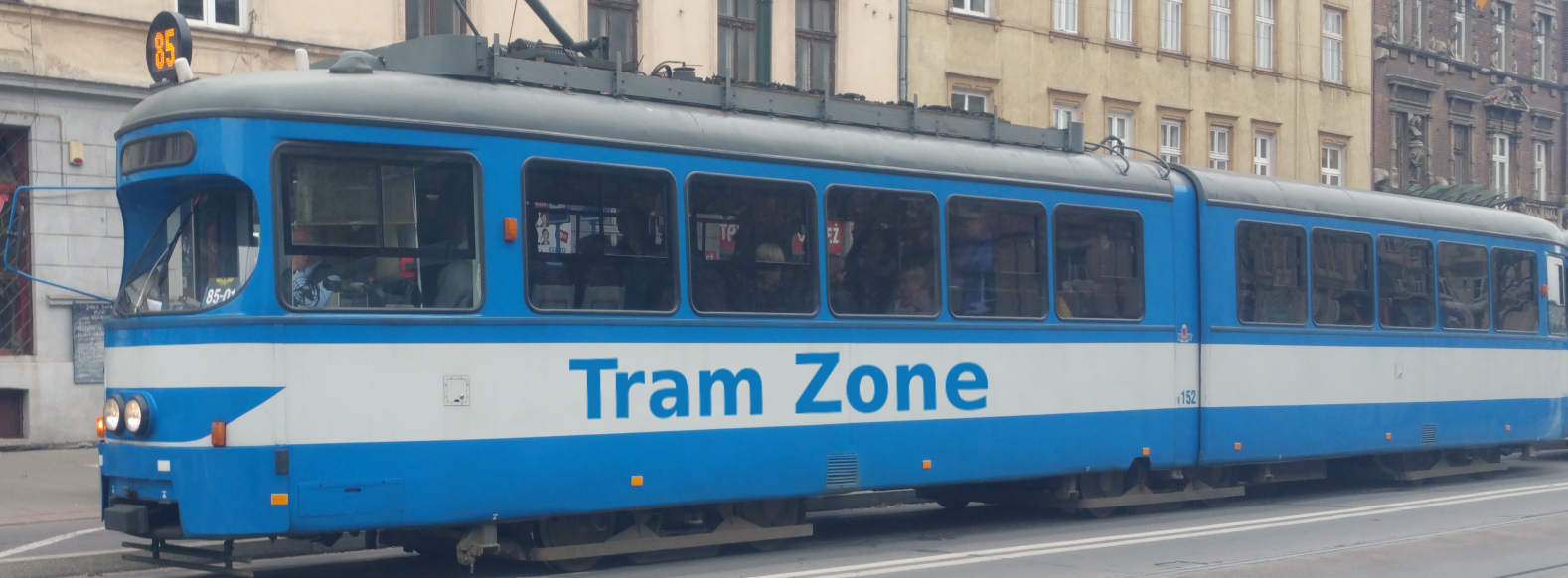Tram systems in Bern
Bern is Switzerland's de facto capital and referred to in Switzerland as the federal city or Bundesstadt, and is situated on the Swiss plateau in the canton of Bern. The city of Bern is Switzerland's fifth-most populous city, with a population of around 145,000. Local legend says that the city of Bern is named by Berchtold V, Duke of Zähringen, the founder of the city, who named it after the first animal he met on a hunt, which turned out to be a bear.
The public transport system within Bern is operated by Bernmobil and is intergrated into the Libero fare network, which covers Bern and Solothurn. The fare network includes any mode of public transport, including trains, trams, buses (including PostAuto buses and the city's trolly buses. The fare system works on the number of zones crosed in a specific period of time, regardless of the transport used. Bahnhof Bern is Bern's central railway station and Switzerland's second busiest station. Bern also has Europ's second shortest public railway line, the Marzilibahn funicular, which runs 106m from the Bundeshaus to the Marzili.
Bern's modern day trams are operated by the Städtische Verkehrsbetriebe Bern (SVB), which also operates the Bern trollybus system and most of Bern's motor buses. The SVB mainly markets itself under the trading name of Bernmobil. The tram system not only covers the urban area of Bern, but also features an interurban line that runs to the municipality of Worb.
Bern currently has 5 tram lines, details of which can be found on the Lines tab
The history of trams in Bern stretches back to October 1890, when Berner Tramway-Gesellschaft (BTG) opened its first line, which ran from Bärengraben to the Bremgartenfriedhof. The sevice used compressed air-powered vehicles of the type developed by the Parisian engineer Louis Mékarski. The compressed air pipes in the trams would often freeze during the winter, leading to days where the line could not operate.
Bern's second tram line was introduced in 1894, running from Länggasse to Wabern, and, in view of the problems with the compressed air trams used on the first line, the city decided to use steam trams on this second line. This was followed in 1898 by he Bern-Worb-Bahn (BWB), which was an interurban line, running from Bern to Worb.
With the turn of the 20th century, work began on Bern's third urban line and in common with many other Swiss and foreign systems, this was developed as an electric line and plans were made to electrify the other lines as well. Line III opened in July 1901 and ran from Breitenrain to Burgernziel via the Zytglogge and for four and a half months, Bern had three different types of tram traction operating at the same time. In mid-November of the same year, the electrification of line I was completed. This was followed at the end of January 1902 by the first electric powered service on line II.
In June 1908, Bern's fourth line (Line IV) opened as a radial route from the central to Brückfeld. In 1911, the routing of lines II, III and IV was changed so that the station became the central interchange point, with line II trams running from Weissenbühl to Papiermühlestrasse, those of line III from Länggasse to Burgernziel, and the trams on line IV from Wabern to Länggasse. At the same time, the naming of the lines changed from Roman to Arabic and the reverse journey with given different identifiers. The lines were identified as follows:
- Line 1 (line 2 in the opposite direction): Bärengraben to Friedhof (this was the former line I).
- Line 3 (line 4 in the opposite direction): Weissenbühl to Papiermühlestrasse (this was the former line II).
- Line 5 (line 6 in the opposite direction): Länggasse to Burgernziel (this was the former line III).
- Line 8 (line 9 in the opposite direction): Wabern to Brückfeld via Friedheim (this was the former line IV).
Some trams on line 9 changed direction at Friedheim and returned to Brückfeld and were designated line 9.
In 1923, the first extension to the system in 15 years took place, with the introduction of a branch line from the Effingerstrasse into Fischermätteli. This led to a small change to the network's operations, with trams from Brückfeld into Fischermätteli being designated line 11 (line 12 for the return journey) and the line to Webern becoming a radial route.
In 1930, there was another reorganisation of the network to tie in with the re-development in the Bahnhofplatz/Bubenbergplatz area, coloured route panels were also introduced. The new lines were:
- Line 1/2 (blue): Friedhof to Brückfeld.
- Line 3/4 (white): Weissenbühl to Papiermühlestrasse.
- Line 5/6 (red): Länggasse to Burgernziel.
- Line 8/9 (yellow): Bärengraben to Wabern via Schönegg. Trams running only as far as Schönegg ran as line 7.
- Line 11/12 (green): Bahnhof to Fischermätteli.
From 1941 onwards, the entire tram network was fully double-tracked and in 1945 an extension of line 5/6 from Burgernziel to Freudenbergerplatz was approved and opened in December 1946. In September 1947, the separate numbering of routes depending on the direction of travel was abandoned and the lines became:
- Line 1: Güterbahnhof to Brückfeld.
- Line 3: Weissenbühl to Bahnhof.
- Line 5: Länggasse to Ostring.
- Line 9: Wabern to Militärplatz.
- Line 11: Fischermätteli to Bahnhof.
In October 1965, line 1 was converted to a motor bus route, reducing the length of the tram system to 13.5km. Over the following decade, there were improvements to the network, the introduction of more modern trains and self-service ticketing, but no major route changes until October 1973 when line 3 was extended from Burgernziel to the new suburb of Wittigkofen. This was followed in 2010 by the conversion of existing motorbus and trollybus routes to Bümpliz, Bethlehem, Ostermundigen and Wyler to tram operaton. At the same time, the line to Worb was renamed as Line 6, and extended to Fischermätteli. This left the network with the 5 lines that are still in operation today.
Map of Bern's current tram system

Bern currently has 5 tram lines, which are listed below. To see more information about a particular line, click on the link in the table below (where applicable).
| Line | Descrption |
|---|---|
| 3 | Line 3 runs from Bern Bahnhof to Weissenbühl. |
| 6 | Line 6 runs from Fischermätteli to Worb Dorf. |
| 7 | Line 7 runs from Bümpliz to Ostring. |
| 8 | Line 8 runs from Brünnen Westside Bahnhof to Saali. |
| 9 | Line 9 runs from Wabern to Wankdorf Bahnhof. |
